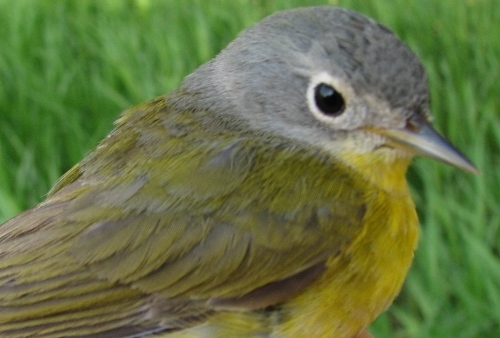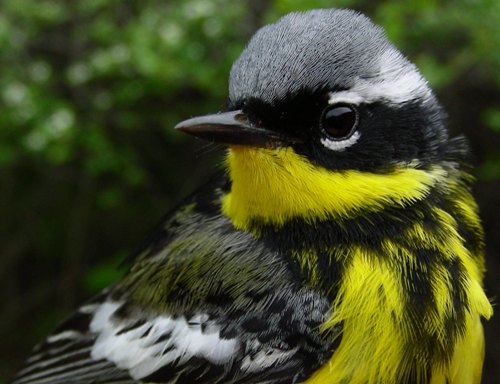|
|
THIS WEEK |
THIS SPRING |
2009 TOTAL |
SITE TOTAL |
|
# birds (and species) banded |
299 (44) |
598 (60) |
630 (62) |
19551 (105) |
|
# birds (and species) repeat |
83 (18) |
162 (24) |
162 (24) |
3510 (65) |
|
# birds (and species) return |
30 (15) |
86 (22) |
92 (24) |
546 (34) |
|
# species observed |
97 |
138 |
140 |
197 |
|
# net hours |
554.5 |
2294 |
2318 |
32783.3 |
|
# birds banded / 100 net hours |
54.9 |
26.1 |
27.2 |
59.6 |
|
|
Note: table does not include nocturnal banding (owls) |
Banders-in-charge: Simon Duval, Gay Gruner, Marie-Anne Hudson, Lance Laviolette
Assistants: Christine Barrie, Sarah Briand, Dave Davey, Andrée Dubois-Laviolette, Benoît Duthu, Nicky Fleming, Marie-Melissa Kalamaras, Gillina Kinsman, Meghan Laviolette, Barbara MacDuff, Eve Marshall, Mike Mayerhofer, Betsy McFarlane, Chris Murphy, James Murray, Rodger Titman, Carine Touma
Notes: What an incredible week! The migration floodgates finally opened this week and inundated us with our little feathered jewels: the warblers. We’ve banded almost triple the number of birds this week compared to last week, and in fact this week accounted for exactly half of the birds we've banded this entire spring season. It was also double the number from last year at this time, and our busiest spring week ever by nearly 100 birds (202 banded in week 7 of 2007). The number of species was also up this week, both in terms of birds observed and birds banded (95 species observed last week, 90 this week last year; 34 species banded last week, 27 species banded this week last year). The day that carried this week was Monday, with 75 species observed in one day alone!
Nine species were added to the list of species observed (chronologically): Wilson’s Warbler, House Sparrow (Sunday), Grey-cheeked Thrush and Blackpoll Warbler (Monday), Willow Flycatcher, Wood Thrush, Red-eyed Vireo (Tuesday), Chimney Swift (Thursday), and Eastern Wood-Pewee (Friday). This brings us to 138 for the season, our highest count ever at this point of spring. Not to be outdone, 16 species were banded for the first time this season: Hairy Woodpecker, Great-crested Flycatcher, Veery, Tennessee Warbler, American Redstart, Chestnut-sided Warbler, Northern Parula (all on Saturday), Wilson’s Warbler (Sunday), Traill’s Flycatcher, Black-and-white Warbler (Monday), House Wren, Cape May Warbler (Wednesday), Warbling Vireo (Thursday), and Red-eyed Vireo, Blackpoll Warbler, Canada Warbler (Friday) … and all this with only two weeks left in the season!
This week’s top observed species only hints at what we’ve had at the nets, with Yellow Warbler creeping up to fifth spot from tenth last week, and with the addition of Tennessee Warbler in seventh position. The rest of the table has been shuffled around a little, the most notable change being the drop in abundance of Canada Goose. They’ve certainly settled down now, the migrants being long gone and the residents having gotten down to the business of breeding.
We’ve decided that we should make predictions more often! Last week we predicted that more than three spots in the top ten banded would be taken up by warblers. That prediction came true with seven out of 10 spots taken! We never would have guessed in a million years that the top spot would be taken by Tennessee Warblers though - in one day this week we banded more of them than in any previous full spring season! The number of Magnolia Warblers banded this week also exceeds all previous spring totals, perhaps a carry-over from the record numbers we recorded last fall. This spring has been really interesting in its comings and goings: we’ve had so many species appear all of a sudden in large number for a day or two, then suddenly disappear only to be replaced with another species doing the same thing. We saw it with Eastern White-crowned Sparrows and Blackpoll Warblers, with Common Yellowthroat and Wilson’s Warblers and with Northern Waterthrush and Tennessee Warblers. It certainly makes for some interesting days at MBO!
|
This week's
top 10 [last week's rank in brackets] |
|
#
individuals banded |
mean #
individuals observed daily |
1. Tennessee Warbler (36) [-] |
1. Ring-billed Gull (78.7) [4] |
2. Yellow Warbler (29) [3] |
2. Red-winged Blackbird (35.9) [3] |
3. Magnolia Warbler (26) [4] |
3. Cliff Swallow (22.1) [2] |
3. Yellow-rumped Warbler (26) [9] |
4. American Crow (15.3) [7] |
5. Eastern White-crowned Sparrow (20) [9] |
5. Yellow Warbler (14.1) [10] |
6. Common Yellowthroat (17) [9] |
6. Tree Swallow (14.0) [6] |
7. Red-winged Blackbird (16) [1] |
7. Tennessee Warbler (12.9) [-] |
8. Northern Waterthrush (15) [-] |
8. Common Grackle (10.1) [6] |
8. Wilson's Warbler (15) [-] |
9. American Goldfinch (10.0) [-] |
10. American Goldfinch (13) [-] |
10. Canada Goose (9.7) [1] |
|
|

We would have loved to post this young female Nashville Warbler's photo more prominently above since she's a foreign recapture (i.e. not banded by us), but we're still waiting on information concerning when and where she was banded. We'll keep you posted!
(Photo by Barbara Frei)
|


